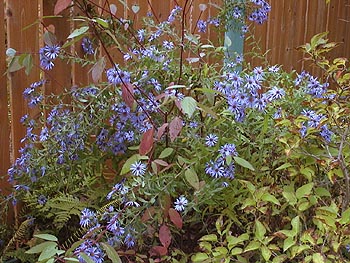Aster novae-angliae 'Our Latest One'
NEW ENGLAND ASTER
Family: Asteraceae
Pronounced: A-ster NO-vie-ANG-glee-ie
Quick Jumps
Growing Guide
Rainy Side Notes
GROWING GUIDE

Origin:
Garden.
Plant group:
Herbaceous perennial.
Hardiness:
Sunset zones: 1-24.
USDA zones: 2-9.
Mature size:
Height: 3-4 feet (1.1 — 1.2 m).
Width: 3-4 feet (1.1 — 1.2 m).
Flowering period:
October to November.
Flowering attributes:
Soft purple flowers with yellow centers.
Leaf attributes:
Lance-shaped basal leaves.
Growth habit:
Clump forming.
Light:
Full sun to partial shade.
Soil:
Moist, fertile soil.
Feeding:
Side dress with compost or manure. Fertilize in spring with a complete organic fertilizer.
Propagation methods:
Divide in winter. | Softwood cuttings in spring.
Pruning methods:
Pinch out tips while growing until July. Photos above show plants that weren't pruned that flopped everywhere. Cut back hard after flowering.
Pests and diseases:
Possible problems are Verticillium wilt and powdery mildew. Slugs may be a problem while plants are young. I have not had a problem with diseases on these asters and slug problems are minimal.
Rainy Side Notes
Rainy Side Notes

Aster means a star, referring to the flower head. The now defunct Montrose Nursery introduced this beautiful aster. Aster novae-angliae ‘Our Latest One’ is tolerant of wet soils, a plus for growing in our maritime Pacific Northwest wet, winter soils. As the name says, it is the latest aster to bloom in my garden.
For best quality, divide plants every 3 years.
New England asters last as a cut flower for 5-7 days when properly harvested. Cut the stems when ¼ of the flower has opened and place it immediately into water.
Photographed in author's garden.

Gardening for the Homebrewer: Grow and Process Plants for Making Beer, Wine, Gruit, Cider, Perry, and More
By co-authors Debbie Teashon (Rainy Side Gardeners) and Wendy Tweton
Copyright Notice | Home | Search | Perennials

